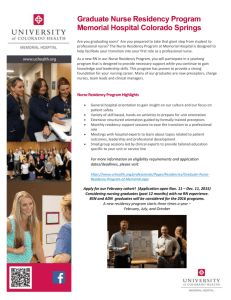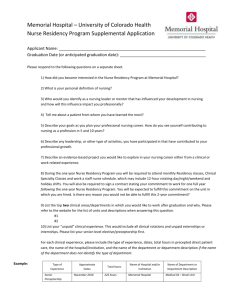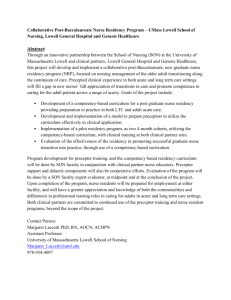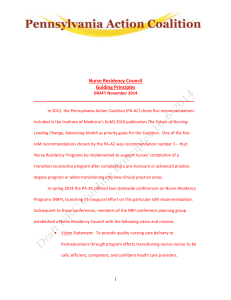Nurse Residency Program Handout
advertisement
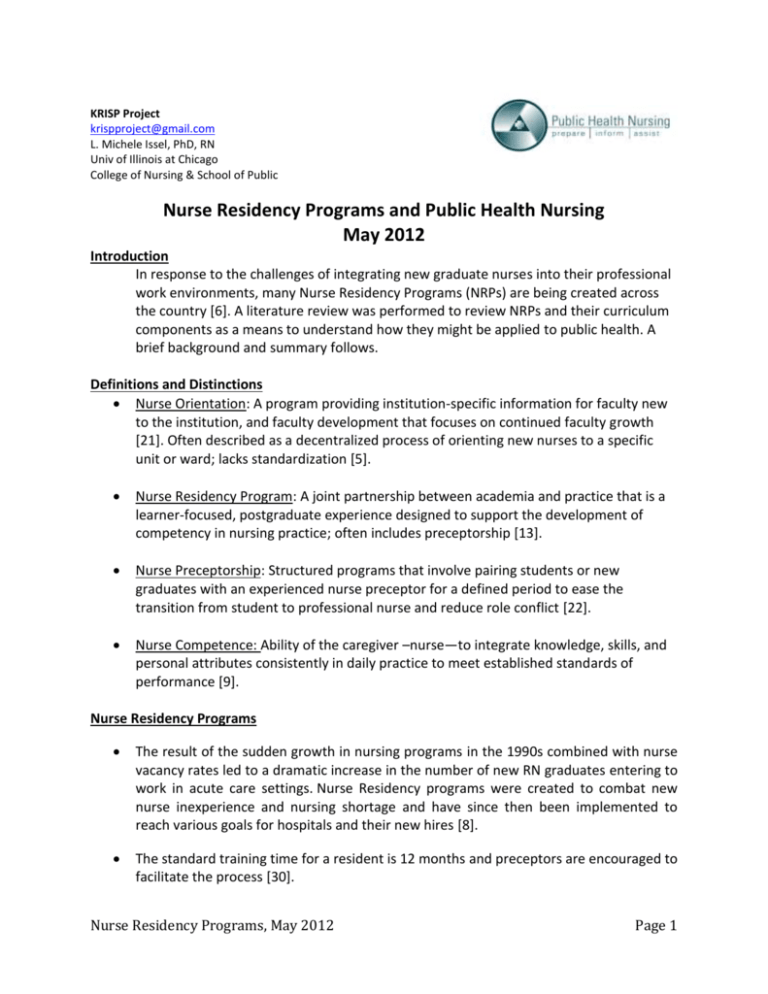
KRISP Project krispproject@gmail.com L. Michele Issel, PhD, RN Univ of Illinois at Chicago College of Nursing & School of Public Nurse Residency Programs and Public Health Nursing May 2012 Introduction In response to the challenges of integrating new graduate nurses into their professional work environments, many Nurse Residency Programs (NRPs) are being created across the country [6]. A literature review was performed to review NRPs and their curriculum components as a means to understand how they might be applied to public health. A brief background and summary follows. Definitions and Distinctions Nurse Orientation: A program providing institution-specific information for faculty new to the institution, and faculty development that focuses on continued faculty growth [21]. Often described as a decentralized process of orienting new nurses to a specific unit or ward; lacks standardization [5]. Nurse Residency Program: A joint partnership between academia and practice that is a learner-focused, postgraduate experience designed to support the development of competency in nursing practice; often includes preceptorship [13]. Nurse Preceptorship: Structured programs that involve pairing students or new graduates with an experienced nurse preceptor for a defined period to ease the transition from student to professional nurse and reduce role conflict [22]. Nurse Competence: Ability of the caregiver –nurse—to integrate knowledge, skills, and personal attributes consistently in daily practice to meet established standards of performance [9]. Nurse Residency Programs The result of the sudden growth in nursing programs in the 1990s combined with nurse vacancy rates led to a dramatic increase in the number of new RN graduates entering to work in acute care settings. Nurse Residency programs were created to combat new nurse inexperience and nursing shortage and have since then been implemented to reach various goals for hospitals and their new hires [8]. The standard training time for a resident is 12 months and preceptors are encouraged to facilitate the process [30]. Nurse Residency Programs, May 2012 Page 1 Many organizations identify Nurse Residency Programs as a vital component in easing the transition of new student nurses and aiding in their recruitment and retention [15, 16, 28]. While successful, such programs have been implemented largely in acute or critical care hospital settings, frequently in university-affiliated teaching hospitals, centered on acute and critical care nursing, but are obsolete in the public health sector. Outcomes of Nurse Residency Programs Increased residents’ confidence, competence and readiness for independent practice [5, 23, 10]. Strengthened assessment and clinical skills; enhanced ability to apply critical thinking to clinical practice [5] Increase in job satisfaction, leading to decreased nurse turnover rate and recruitment and orientation costs [12, 17] Increased Nurse retention rates and correlating recruitment and training costs [16, 14,24, 32] Improved clinical competency, decreases sense of threat and improves communication and leadership [14, 23] Common Nurse Residency Programs Curriculum Components A literature review was conducted using the key words: Nurse Residency Programs in CINHAL, Ovid, EBSCO, Web of Science and Pub Med databases. The most prevalent curriculum components from US-based programs lasting 12 months or more in duration are as follows: Leadership [1, 21, 7, 11, 17, 19, 25, 26, 27] Evidence-based Practice [1, 21, 7, 11, 17, 19, 25, 26] Patient Safety [1, 2, 21, 7, 11, 17, 19, 25, 26, 27] Unit-Specific Skills [1, 2, 21, 7, 11, 17, 19, 25, 26, 27] Professionalism [1 , 2, 21, 7, 11, 17, 19, 25, 26, 27] Time Management [1, 2, 21, 7, 11, 19] Organization and Prioritization of Care [1, 2, 21, 7, 11, 19, 25, 26] Resource Management [1, 7, 11, 17, 19, 25, 26 27] Care Management [1, 2, 21, 7, 11, 17, 19, 25, 26, 27] End of Life Care /Aging [1 , 21, 7, 11, 17, 19, 25, 26, 27] Culture and Diversity [1, 7, 11, 17, 19, 25, 26, 27] Stress Management [1, 21, 7 11, 17, 19, 25, 26] Patient Education [1, 7, 11, 17, 19, 25, 26, 27] Self Care for Nurses [1, 6, 11, 19, 25, 26] Interdisciplinary Collaboration [1, 2, 21, 7, 11, 17, 19, 25, 26, 27] Communication [1, 2, 7, 11, 17, 19, 25, 26, 27] Critical Thinking [1, 2, 21, 7, 11, 17, 19, 25, 26, 27] Nurse Residency Programs, May 2012 Page 2 Conflict Resolution [1, 21, 7, 11, 19, 25, 26, 27] Delegation to UAP [1, 21, 7, 11, 19, 25, 26, 27, 17, 19, 25, 26] Critical Events [1, 2, 11] Application to Public Health The Quad Council of Public Health Nursing (Quad Council) competencies are a means for PHNs to understand their role in a meaningful way and to integrate knowledge, skills, and personal attributes consistently in daily practice to meet established standards of performance in public health. These competencies are listed as eight competency domains: analytic assessment, policy development/program planning, communication, cultural competency, community dimensions of practice, basic public health sciences, financial planning and management, leadership and systems thinking. Current established Nurse Residency Programs only cover a small percentage of these competencies and therefore would require extensive restructuring to meet the needs of public health nurses. References 1. Altier, M.E., & Kresk, C.A. (2006). Effects of a 1-year Residency Program on Job Satisfaction and Retention of New Graduate Nurses. Journal for Nurses in Staff Development, 22(2), 7077. 2. Anderson, T., Lidnen, L., Allen, M., & Gibbs, E. (2009). New graduate RN work satisfaction after completing an interactive nurse residency. Journal of Nursing Administration, 39(4), 165-169. 3. Beecroft, P., Hernandez, A.M., & Reid, D. (2008) Team preceptorships: A new approach for precepting new nurses. Journal for Nurses in Staff Development, 24(4), 143-148. 4. Beyea, S.C., Slattery, M.J., & von Reyn, L.J. (2010). Outcomes of a simulation-based nurse residency program. Clinical Simulation in Nursing, 6(5), 169-175. 5. Beyea, S.C., von Reyn, L., & Slattery, M.J. (2007). A nurse residency program for competency development using human patient simulation. Journal for Nurses in Staff Development, 23(2), 77-82. 6. Casey, K., Fink, R., Krugman, M., & Propst, J. (2004). The graduate nurse experience. Journal of Nursing Administration, 34(6), 303-311. Nurse Residency Programs, May 2012 Page 3 7. Chesnutt, B.M., & Everhart, B. (2007). Meeting the needs of graduate nurses in critical care orientation: Stages orientation program in surgical intensive care. Critical Care Nurse, 27(3), 36-51. 8. Dracup, K. (2007). Nurse residency programs: Preparing for the next shift. American Journal of Critical Care, 16(4), 328-335. 9. Fey, M.K., & Miltner, R.S. (2000). A competency-based orientation program for new graduate nurses. Journal of Nursing Administration, 30(3), 126-132. 10. Fink, R., Krugman, M., Casey, K., & Goode, C. (2008). The graduate nurse experience: Qualitative residency program outcomes. Journal of Nursing Administration, 38(7), 341-348. 11. Goode, C.J., & Williams, C.A. (2004). Post-Bacclaaureate Nurse Residency Program. JONA, 34(2), 71-77. 12. Halfer, D., Graf, E., & Sullivan, C. (2008). The organizational impact of a new graduate pediatric nurse mentoring program. Nursing Economic$, 26(4), 243-249. 13. Hedrich, B. & Lindsay, A. (2006). Nurse Residency Programs: Redesigning transition into practice. Journal for Nurses in Staff Development, 22(2), 55-62. 14. Hillman, L., & Foster, R.R. (2011). The impact of a nursing transition programme on retention and cost savings. Journal of Nursing Management, 19(1), 50-56. 15. The Institute of Medicine. (2010). The Future of Nursing: Leading Change, Advancing Health. Washington, DC: Committee on the Robert Wood Johnson Foundation Initiative on the Future of Nursing, at the Institute of Medicine 16. Joint Commission on Accreditation of Healthcare Organizations. (2002). Healthcare at the crossroads: Strategies for addressing the evolving nursing crisis. Retrieved 01 March 2012 from www.jcaho.org. 17. Keller, J.L., Meelins, K., & Summers, B.L. (2006). Pearls and pitfalls of a new graduate academic residency program . Journal of Nursing Administration, 36(12), 589-598. DOI: 10.1097/00005110-200612000-00010 18. Kowalski, S., & Cross, C.L. (2010). Preliminary outcomes of a local residency programme for new graduate registered nurses. Journal of Nursing Management, 18, 96-104. 19. Krugman, M., Bretschneider, J., Horn, P.B. Krsek, C.A., Moutafis, R.A, & Oare Smith, M. (2006). The National Post- Baccalaureate Graduate Nurse Residency Program. Journal for Nurses in Staff Development, 22(4), 196-205. 20. Lindsey, G., & Kleiner, B. (2005). Nurse Residency Program: An effective tool for recruitment and retention. Journal of Health Care Finance, 31(3), 25-32. 21. Meyer-Bratt, M. (2009). Retaining the Next Generation of Nurses: The Wisconsin Nurse Residency Program Provides a Continuum of Support. The Journal of Continuing Education in Nursing, 40(9), 416-425. 22. Morin, K. H., & Ashton, K. C. (2004). Research on faculty orientation programs: Guidelines and directions for nurse educators. Journal of Professional Nursing, 20(4), 239-250. 23. Olson, R.K., Nelson, M., Stuart, C., Young, L., Kleinsasser, A., Schroedermeier, R.,…Newstrom, P. (2001). Nursing Student Residency Program: A model for seamless transition from nursing student to RN. JONA, 31(1), 40-48. Nurse Residency Programs, May 2012 Page 4 24. Owens, D.L., Turjanica, M.A., Scanion, M.W., Sandhusen, A.E., Williamson, M.W., & …Facteau, L. (2001). New graduate RN internship program: A collaborative approach for system-wide integration. Journal for Nurses in Staff Development, 17(3), 144-150. 25. 24, R., & Tart, K. (2007). Return on Investment: Benefits and Challenges of a Baccalaureate Nurse Residency Program. Nursing Economics, 25(1): 13-18. 26. Poynton, M.R., Madden, C., Bowers, R., & Keefe, M. (2007). Nurse Residency Program Implementation: The Utah Experience, Journal of Healthcare Management, 52(6), 385-397. 27. Puntil, C. (2005). New Graduate Orientation Program in a geriatric psychiatric inpatient setting. Issues in Mental Health Nursing 26(1), 65-80. 28. Robert Wood Johnson Foundation. (2002). Healthcare human crisis: The American nursing shortage. Retrieved 02 March 2012 from: http://rwjf.org. 29. Rosenfeld, P., Smith, M.O., Iervolino, L., & Bowar-Ferres, S. (2004). Nurse Residency Program: A 5-Year Evaluation from the Participants’ Perspective. JONA, 34(4), 188-194. 30. University Health Consortium. (2012). UHC/AACN Nurse Residency Program. Accessed 27 February, 2012 from https://www.uhc.edu/16807.htm. 31. Welding, N.M. (2011). Creating a Nursing Residency: Decrease Turnover and Increase Clinical Competence. MedSurg Nursing, 20(1), 37-40. 32. Williams, C.A., Goode, C.J., Krsek, C., Bednash, G.D., & Lynn, M.R. (2007). Postbacclaureate nurse residency 1-year outcomes. Journal of Nursing Administration, 37(7), 357-365. Nurse Residency Programs, May 2012 Page 5
